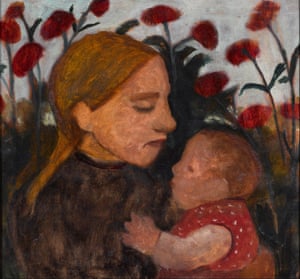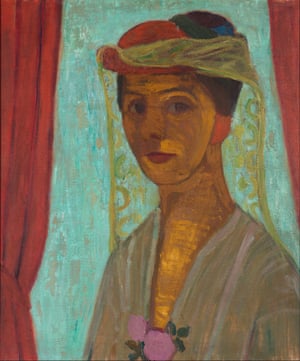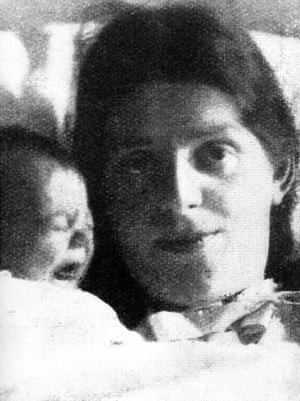https://www.theguardian.com/books/2017/nov/04/being-here-life-paula-modersohn-becker-marie-darrieussecq-review
Being Here: The Life of Paula Modersohn-Becker review – the story of women’s art
She worked at fever pitch, producing 80 pictures in a year, and was dead by 31 – an intense and fragmentary account of a unique artist by Marie Darrieussecq
 Girl with child, 1902, by Paula Modersohn-Becker. Photograph: Heritage Images/Getty Images
Girl with child, 1902, by Paula Modersohn-Becker. Photograph: Heritage Images/Getty ImagesSaturday 4 November 2017 10.30 GMT
Paula Modersohn-Becker was the first woman to paint a naked self-portrait – and while apparently pregnant, at that – in 1906. She worked at fever pitch, bemoaning the waste of her first two decades and producing in her penultimate summer a painting every four or five days. Regularly described as an expressionist, her portraits don’t look like anything or anyone else. Her women are crude and exact, glowing with strange colours: Balthus as a feminist, Gauguin by way of The Dark Crystal. She died in 1907 at the age of 31, having sold three paintings in her lifetime, leaving behind a forest of letters and diaries.
Marie Darrieussecq, a French writer best known in the UK for her startling 1996 debut novel Pig Tales, first came across Modersohn-Becker in an email in her junk folder, illustrated with a small picture of a woman breastfeeding. It was so unfamiliar it stopped her in her tracks. She couldn’t understand why she didn’t already know about this German artist who painted real women, real behaviour with such confident frankness. Why was she not exhibited in Paris, the city she had made her home? “Do we have to assume that she did not have her universal visa?”
In Darrieussecq’s hands, Modersohn-Becker’s story is both individual and exemplary: a frightening, energising fable that weirdly resembles a 19th-century version of Viv Albertine’s punk memoir Clothes, Clothes, Clothes, Music, Music, Music, Boys, Boys, Boys, with Sid Vicious recast as the poet Rainer Maria Rilke. Paula Becker began to draw seriously at the age of 16. Her father insisted she train as a teacher, but a lucky inheritance allowed her to move to the artists’ colony Worpswede, in Germany, later also home to Rilke, the only artist to truly grasp her merit. She had a knack for seizing the moment, taking every chance that came her way.
In 1900 she made her first trip to Paris, studying drawing and anatomy. The city electrified her, and she longed to share it. She wrote a bold letter to a married painter she’d become close to in Worpswede, begging him to join her, with or without his ill wife. Otto Modersohn initially demurred, not wanting to expose himself to modern art. In the end, her enthusiasm prevailed, and four months later, following the death of his wife, Becker was engaged to her.
The transition from single woman to wife was salted with small humiliations. When she got engaged, her family sent her to a Berlin cookery school for two months, where she conquered veal fricassee and meatloaf. Her father wrote to tell her she must learn to forget about herself, his joyful daughter, who had won first prize at the Académie Colarossi, that she must relinquish egotism. The history of all women’s art: she didn’t relinquish it.
On Easter Sunday 1902, while cooking a roast, Modersohn-Becker paused to write a heartfelt note in her housekeeping book: “Marriage does not make one happier. It takes away the illusion that had sustained a deep belief in a kindred soul.” That same year, after completing an extraordinary, exalted painting of a girl in an orchard, she wrote fiercely to her mother: “I am going to become somebody.”

FacebookTwitterPinterest Self-portrait with Hat and Veil, by Paula Modersohn-Becker, 1906-07. Photograph: Heritage Images/Getty Images
At first Modersohn supported his wife’s ambitions, describing her as “certainly the best woman painter in Worpswede”. But soon he was complaining to his diary about her housekeeping and her work, how she was “falling prey to the error of preferring to make everything angular, ugly, bizarre, wooden … mouths like wounds, faces like cretins”. In another entry he wrote crossly: “Women will not easily attain something proper.”
Darrieussecq’s intense, fragmentary account is at its best on Modersohn-Becker’s escapes, the snatched interludes in Paris, where she could resume her life as a working artist. Hot chocolate in her rented room, visits to the Louvre, buying violets and lunching on fried eggs. Back home, she was happiest in Otto’s absence, when she could live off pears and rice pudding, didn’t have to set the table, could read over her food. She painted pumpkins, cherries, bananas, lemons, the ripe fruit Rilke would later describe in his elegy, “Requiem for a Friend”.
At 30 she left her husband. Her letters from Paris were full of requests for money: 200 marks to pay her rent, 60 francs for models’ fees. Her studio was infested with fleas, there was a heatwave, but she kept working: 80 pictures in 1906. As Rodin told her: “La travaille, c’est mon bonheur.”
In September, she had a change of heart. She reunited with Otto and became pregnant. On 2 November 1907, after two days of labour, she gave birth to a daughter. For the next 18 days she was ordered to stay in bed. At last she was allowed to rejoin the world. A small party was planned. She braided her hair, pinned a rose to her housecoat, got out of bed and fell down dead, saying schade, a pity. The cause was an embolism, from lying down for so long.
 Paula Modersohn-Becker with her baby in 1907. Photograph: Ullstein Bild/Getty Images
Paula Modersohn-Becker with her baby in 1907. Photograph: Ullstein Bild/Getty ImagesIn “Requiem for a Friend”, Rilke wrote: “And at last you saw yourself as a fruit, you stepped / out of your clothes and brought your naked body / before the mirror, you let yourself inside / down to your gaze; which stayed in front, immense, / and didn’t say: I am that; no: this is.”
In Darrieussecq’s account, Rilke’s sensuality is tinged with horror, doubly haunted by what happened to Germany after Modersohn-Becker’s death, and by the continuing limits to women’s lives. She summons a heaven of detail, these girls in their white empire-line dresses and flower garlands, ignorant of what the future holds, riding their bicycles through the summer nights. Exploring a beach where Modersohn-Becker holidayed, she writes: “Huge bubbles of hot air hang in the trees. When you go in there, it’s like walking into butter.”
Darrieussecq is interested in this bubble, this strange, lost moment in German history, an idyll spanned and clarified by Modersohn-Becker’s short life, before “the slaughterhouse of the 20th century” got under way. The posthumous publication of Modersohn-Becker’s letters by her mother made her a star, with multiple exhibitions and a museum devoted to her work. But in 1937, 70 of her paintings were purged from German museums, either destroyed or exhibited as “degenerate art”. The Nazi critique was weirdly close to her husband’s: “Her vision is so lacking in femininity and so vulgar … A revolting mixture of colours, of idiotic figures, of sick children, degenerates, the dregs of humanity.”
The other horror here is of being a woman, penned up alive. In an aside, Darrieussecq describes how in Roman times adulterous women were buried in the marshes around Worpswede with their breasts facing up, “their mouths open to the horror of the peat”. Modersohn-Becker’s short life is mirrored by the claustrophobic fate of her best friend, the sculptor Clara Westhoff, who married Rilke, had a child and became mired in domestic poverty. Rilke so hated the baby crying that it was taken in by Westhoff’s mother. When the family reunited a year later, she didn’t recognise her parents.
Truncated lives, unnecessary limits. There’s only one thing to do next. Look at the girls Modersohn-Becker painted, with their slim arms, their strong heads set against the sky. As Darrieussecq puts it: “It is not about what these young girls are dreaming, but what they are thinking … These girls are saying: ‘Leave us alone!’”
• Olivia Laing’s The Lonely City is published by Canongate.
• Being Here: The Life of Paula Modersohn-Becker is published by Text. To order a copy for £11.04 (RRP £12.99) go to bookshop.theguardian.com or call 0330 333 6846. Free UK p&p over £10, online orders only. Phone orders min p&p of £1.99.
沒有留言:
張貼留言